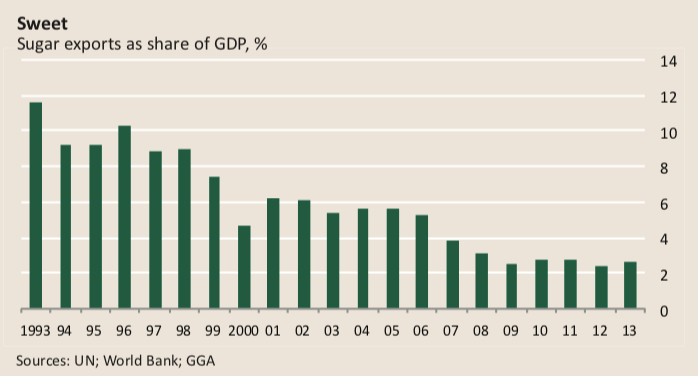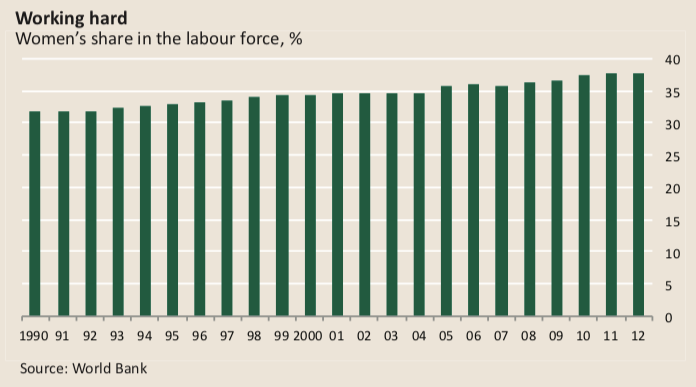Mauritius: map to prosperity
Economic freedom and a flat tax have helped the island become a middle-income nation
In 1960 Nobel prize-winning British economist James Meade said Mauritius had no economic future. At the time the island nation, 2,000km east of mainland Africa, depended almost entirely on sugar for revenue and employment. In 1975, with 40% of Mauritian households below the poverty line, according to the country’s central statistics office, the prediction seemed accurate. Over the past 40 years, however, Mauritius has reinvented itself and proved Mr Meade and other naysayers wrong.
The change has been most marked in the last 20 years. Since 1994 Mauritius’s gross national income (GNI) per capita has almost trebled, according to the World Bank—soaring from $3,230 in 1994 to $9,300 in 2013—moving the population of 1.3m from the “lower middle income” into the “upper middle income” category of nations, according to the bank. The significantly higher GNI per capita indicates a substantial growth in the country’s middle class.
With its exquisite coastline, Mauritius is best known as an idyllic holiday destination, but its attractiveness as an investment destination has been one of the pillars of its recent success. Its low flat tax of 15% for individuals and companies spurs investment and attracts foreign direct investment (FDI).
The individual marginal tax rate in 2005 was 30%. The 2006 budget introduced a flat rate tax of 22.5% and provided for this to be reduced by 2.5 percentage points a year so it would be down to a final rate of 15% by 2009. Individuals earning less than about $800 a month, or those with three dependents earning less than $1,420 per month, were excluded from the tax net. The budget made provision to gradually reduce corporate tax to 15% and to eliminate more than 20 complex special allowances.
The aim of a low flat tax is to simplify the tax system, reduce compliance costs, improve incentives to work, save and invest, eliminate economic distortions, broaden the tax base and reduce tax rates, according to US economists Robert Hall and Alvin Rabushka in their book “The Flat Tax”. Tax expenditure in Mauritius has been cut from 3.23% of GDP in 2006 to 1.3% in 2012, according to Mauritian finance ministry figures.
But a low tax rate alone does not explain the increase in Mauritian well-being. Supportive policies and pro-growth institutions are also behind the rapid increase in incomes.
The country’s modern economic renaissance began in the early 1990s, when the government of Prime Minister Anerood Jugnauth created a series of “development hubs” and “pillars of the economy”—areas of the economy with the greatest potential to boost growth and provide employment, identified after consulting business leaders.
The government heightened spending on tourism, hospitality and leisure. It also invested heavily in financial services and offshore banking; information and communication technology (including an undersea cable connection to boost internet connectivity); and road and airport improvements.
Development hubs included the creation of a container terminal at Port Louis, a free port on the island’s west coast, and export processing zones (EPZs) throughout the island to promote manufacturing and export.
The government’s pursuit of economic diversity took the pressure off the sugar crop. Sugar exports as a percentage of GDP fell from 40% in 1976 to just 0.5% in 2010, according to government figures. This widened employment opportunities.

In the early 1990s, for example, only a minority of women had jobs and worked mainly for sugar-related companies or parastatals, according to a 2002 report by Brian Chernoff and Andrew Warner for the Center for International Development at Harvard University. With the establishment of manufacturing plants in the EPZs, this culture changed: women started working in the zone’s knitwear and apparel factories. By 1995, 80,466 employees, predominantly women, worked for the 481 firms in Mauritius’ EPZs, according to a 2011 World Bank report. Drawing women into the labour force expanded family incomes.
The next chapter in the Mauritius success story began in 2006. In his budget speech that year, Rama Sithanen, then deputy prime minister and minister of finance, announced 40 reform measures to boost employment and economic growth and reduce poverty. These reforms abolished several ineffective incentive schemes and streamlined the process of doing business in Mauritius, including reducing the time to register companies.
The reforms “ushered the country into a new phase of economic development”, according to Maurice Lam, chairman of the government’s Board of Investment. The goal was “to enhance the attractiveness of Mauritius as a platform for global business so that both domestic and foreign investments create employment and wealth resulting in higher living standards for the population of Mauritius”, wrote Mr Lam at the time.
Crucially, people from across the political and economic spectrum supported the reforms.
One of the Mr Sithanen’s stated aims was to take Mauritius into the top ten countries on the World Bank’s Ease of Doing Business index. While this ambition has not been realised, it did make it to the top 20 in 2013, up from 31st in 2006. In addition, the Economic Freedom of the World 2013 Annual Report ranked Mauritiusthe 6thfreest economy in the world, up from 28thin 2005, making it the leading sub-Saharan African country on both indices.

Mauritius’s current unemployment rate is estimated at an impressive 8.0%, according to Statistics Mauritius. At the end of January 2014, 39,378 expatriates worked on the island, mostly in manufacturing and construction, according to Statistics Mauritius, compared to 20,000 in 2006, according to figures from Enterprise Mauritius, a Port Louis-based trade-promotion organisation Comparing the two surveys shows that the number of foreign workers has almost doubled. This indicates that Mauritians do not want to work in certain jobs, a phenomenon that occurs hand in hand with an increase in family incomes.
When Mr Meade made his negative prediction, the world was a very different place. He could not have anticipated, for example, that advanced electronics would allow Mauritius to house call centres handling enquiries from France. But perhaps there is another reason for his mistake. As Sellapan Ramanathan Nathan, former president of Singapore, suggested during a state visit to Mauritius in 2011: “Today, both our countries are hailed as economic miracles, perhaps because conventional wisdom had doomed us to failure after independence.”
Half a century after being written off, Mauritius continues to grow by creating the conditions and opportunities for its people to rise out of poverty. It has succeeded by following free-market fundamentals: a low flat tax, greater economic activity and trade, and increased economic freedom
[author] [author_image timthumb=’on’][/author_image] [author_info]Eustace Davie is a director of the Free Market Foundation, an independent policy organisation that promotes economic freedom. He writes regularly for this NGO on energy, unemployment, regulation and other economic issues. [/author_info] [/author]


